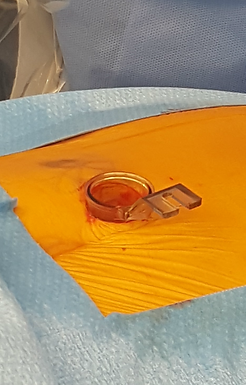
Minimally Invasive Spine Surgery
What is Minimally Invasive Spine Surgery?
The goal of minimally invasive spinal surgery (MIS) is to minimize trauma all soft tissues surrounding the spine, resulting in less blood loss, less pain, and a faster recovery time. Traditional or "open" surgery is still the mainstay of treatment for many patients, depending on the diagnosis and severity of disease.
In MIS, the skin incision(s) is/are usually much smaller, but the effect on the soft tissues can be much more profound than that. The length of the incision doesn't tell the whole story about the surgery that was performed underneath. In MIS, muscles are separated and split vertically, their attachments to the bone are often left in place, allowing for less bleeding and pain.
Endoscopic tubes are used to spread muscles out of the way, and specialized tools are used to access the spine in a small space. More xrays are used, and often stereo-tactic computer-aided navigation will help the surgeon to indirectly visualize spinal structures and instruments with directly seeing them. This requires specialized surgical training and the learning curve may be difficult.
An MIS operation isn't simply better because it is minimally invasive. Often, the most appropriate option for surgery is through direct visualization and an "open" approach. Sometimes patients believe they will choose a surgeon who offers an MIS procedure first, and that they can always be treated with an open procedure with similar results if the minimally invasive surgery doesn't produce satisfactory results. Unfortunately, there are still the same risks involved with MIS surgery, and these can be compounded by an inexperienced surgeon who has not trained in these techniques. A poor MIS surgery outcome may limit options or increase risks of any subsequent "open" procedure. Dr. Bjerke has trained with both "open" and MIS techniques, and is therefore able to offer patients the most appropriate and individualized plan of care for his patients.

Dr. Bjerke performing MIS fusion using computer-aided navigation to minimize muscle damage and increase accuracy of surgical instruments.

Xrays are used to locate the exact place on the spine for surgery. Metal "dilators" are used to spread and push muscles aside.

An endoscopic tube is attached to a fixed arm (right), and safely positioned for the operation.

The final tube requires an incision that is less than one inch, and minimizes soft tissue damage.
An MIS operation isn't simply better because it is minimally invasive. Often, the most appropriate option for surgery is through direct visualization and an "open" approach. Sometimes patients believe they will choose a surgeon who offers an MIS procedure first, and that they can always be treated with an open procedure with similar results if the minimally invasive surgery doesn't produce satisfactory results. Unfortunately, there are still the same risks involved with MIS surgery, and these can be compounded by an inexperienced surgeon who has not trained in these techniques. A poor MIS surgery outcome may limit options or increase risks of any subsequent "open" procedure. Dr. Bjerke has trained with both "open" and MIS techniques, and is therefore able to offer patients the most appropriate and individualized plan of care for his patients.
Another resource for an overview of MIS, including commonly performed procedures, expectations, and complications can be found here: SpineUniverse: MIS